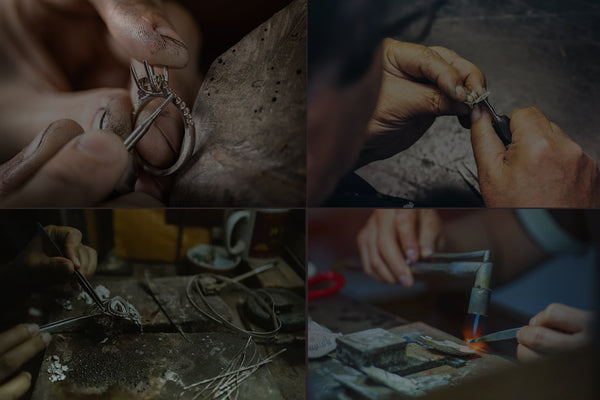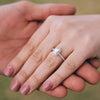
5 Tips For Designing the Perfect Custom Engagement Ring
Designing a custom engagement ring is an exciting and meaningful process. It allows you to create a unique symbol of love that captures your partner's style and personality. We've compiled five essential tips to guide you through the design journey.
-
Understand Your Partner's Style
-
Collaborate with a Skilled Jewelry Designer
-
Select a Unique Center Stone
It is the focal point of any kind of jewelry. Consider a range of gemstone options, such as diamonds, sapphires, emeralds, or even rare colored gemstones. Each gemstone possesses its unique qualities, symbolism, and beauty. Choose a center stone that aligns with your partner's preferences and holds significance to both of you.
creating new and unique shapes for jewelry is an exciting way to introduce fresh concepts and designs. designers often push the boundaries of traditional shapes to offer innovative and captivating pieces. Here are a few examples of how new concepts are being incorporated into it:
-
Dutch Marquise
-
Hexagon Step Cut
It is a six-sided diamond shape with step-cut faceting. It resembles a hexagon or a honeycomb pattern, with long, flat facets that create a mesmerizing play of light and shadow. This shape is ideal for those seeking a geometric and contemporary diamond cut.
-
Spear Cut
-
Portuguese Cut
-
Old Mine Cut
-
Old European Cut
-
Oval Step Cut
-
Cushion Step Cut
-
Butterfly Cut
The Butterfly Cut is a whimsical and intricate diamond shape that resembles a butterfly with outstretched wings. It typically features a symmetrical design with two pairs of elongated marquise-shaped wings. This unique cut offers a playful and feminine option for those seeking a distinctive diamond shape.
-
Pay Attention to the Setting
-
Add Personal Touches
Design Engagement Ring
It is allowing you to create a unique and personalized piece that reflects your style and preferences. Here is a general process to guide you:
Define Your Budget
Determine how much you are willing to spend on the ring, as it will help you make design choices within your financial limits.
Research and Gather Inspiration
Look for inspiration from various sources like jewel stores, online galleries, magazines, and social media platforms. Save images or sketches of designs you like to convey your ideas to a jeweler.
Choose the Gemstone
Decide on the type of gemstone you want for the centerpiece, such as a diamond, sapphire, emerald, or ruby. Consider the cut, color, clarity, and carat weight.
Select the Metal
Decide on the metal for the ring band, such as platinum, gold (yellow, white, or rose), or alternative metals like palladium or titanium.
Customization and Details
Work with an expert or a custom ring designer to create a unique design. Consider the ring's setting style, additional gemstones or accents, and any specific engravings or personal touches you desire.
Finalize the Design
Collaborate with the expert to finalize the design, ensuring it meets your expectations. They will create a rendering or a wax model for your approval before moving forward.
Related Reads: Benefits of Buying a Custom Moissanite Engagement Ring
Related Reads: Top 7 Reasons to Get Your Own Customized Engagement Ring
Design Your Engagement Ring
Several online jewelry retailers offer interactive tools to design your project virtually. These platforms allow you to choose the stone, metal, and design elements step-by-step, giving you a clear visual representation of the final product. Some popular websites include Diamondrensu, Blue Nile, James Allen, and Brilliant Earth.
Build Your Engagement Ring
It’s typically involving a more hands-on approach, where you actively participate in the creation process. This option is suitable for those who have experience in crafting, making or are interested in learning the craft. Here are the general steps involved:
Learn the Basics
Familiarize yourself with the fundamentals of jewelry making, including techniques like metalworking, stone setting, and polishing. You can attend workshops, take courses, or find online resources to gain the necessary skills.
Gather Tools and Materials
Acquire the essential tools and materials required for ring makings, such as a jeweler's saw, files, pliers, soldering equipment, gemstones, and metal sheets or wire.
Plan Your Design
Create a detailed design and blueprint of your ring, considering the metal type, gemstones, and other design elements.
Start the Construction
Begin by shaping the metal band and setting the gemstones according to your design. Follow the techniques you have learned or seek guidance from professionals or experienced stores.
Finishing Touches
Refine the ring's details, polish the metal, and ensure all the elements are securely in place.
Quality Check
Evaluate the final product, ensuring it meets your expectations in terms of aesthetics and craftsmanship.
Remember, some points to keep in mind-requires skill, time, and patience. If you are unsure about the process, it's advisable to consult with a professional jeweler or consider customizing a ring with their assistance.
Working with an Expert
If you prefer a customized ring project but do not want to build it yourself, working with a professional is a great option. Here is what you can expect when collaborating with an Expert:
Find a Reputable Jeweler
Research and choose a trusted jeweler who specializes in custom engagement ring designs. Look for reviews, recommendations, and examples of their previous work to ensure their expertise.
Initial Consultation
Schedule an appointment with the expert to discuss your design ideas, budget, and any specific requirements. Bring along any inspirational images or sketches to convey your vision effectively.
Design Development
Based on your preferences, they will create a design concept or a series of sketches for you to review. They may also provide computer-aided design (CAD) renderings or 3D models to visualize the final product.
Selection of Materials
Choose the gemstone(s) and metal for the ring during the design process. The expert can guide you in selecting high-quality stones and appropriate metals that align with your design and budget.
Refinement and Approval
Collaborate with the designer to refine the design, making any necessary adjustments or additions. Once you're satisfied with the final design, give your approval to proceed.
Crafting the Ring
The craftsman person will create the ring using traditional craftsmanship techniques or advanced technologies like 3D printing and computer-guided milling. This process involves carefully setting the gemstones, creating the band, and adding any requested engravings or embellishments.
Quality Assurance and Finalization
The completed ring will undergo a thorough quality check to ensure it meets your specifications. Once approved, the seller will present you with the finished ring.
Additional Considerations
- Timeline: Keep in mind that designing and building a custom design for any kind of project can take time, especially if you're starting from scratch. It's advisable to begin the process several months in advance to allow for design development, production, and any potential adjustments.
- Budget: It can vary in price depending on factors like the complexity of the design, choice of materials, and craftsmanship involved. Be clear about your budget from the beginning to ensure the jeweler creates a design that fits within your financial means.
- Certification: If you choose a diamond for the centerpiece of your ring, pendant, earrings, bracelet, and more consider opting for a certified diamond. Certification from reputable Gemological laboratories (e.g., GIA, IGI) assures the stone's quality and characteristics.
Jewelry designers are constantly exploring new concepts and shapes to create unique and innovative pieces. They draw inspiration from various sources such as nature, architecture, and geometric abstractions. By experimenting with materials, asymmetry, sculptural forms, and customization, they push the boundaries of traditional jewelry design and offer fresh and captivating options for individuals seeking something truly special. The world of the market continues to evolve, embracing creativity and personal expression.
Leave a comment
Please note, comments must be approved before they are published.


















